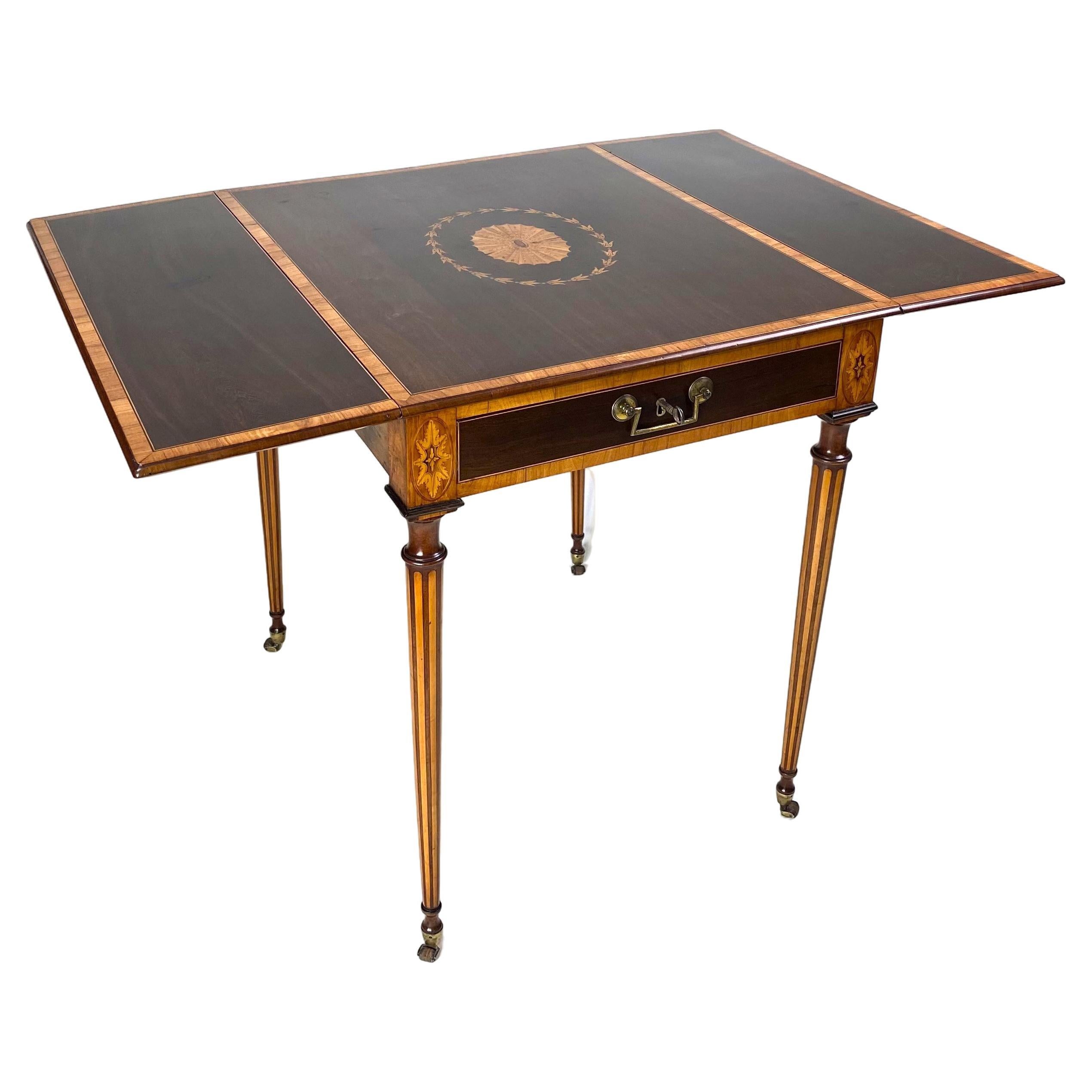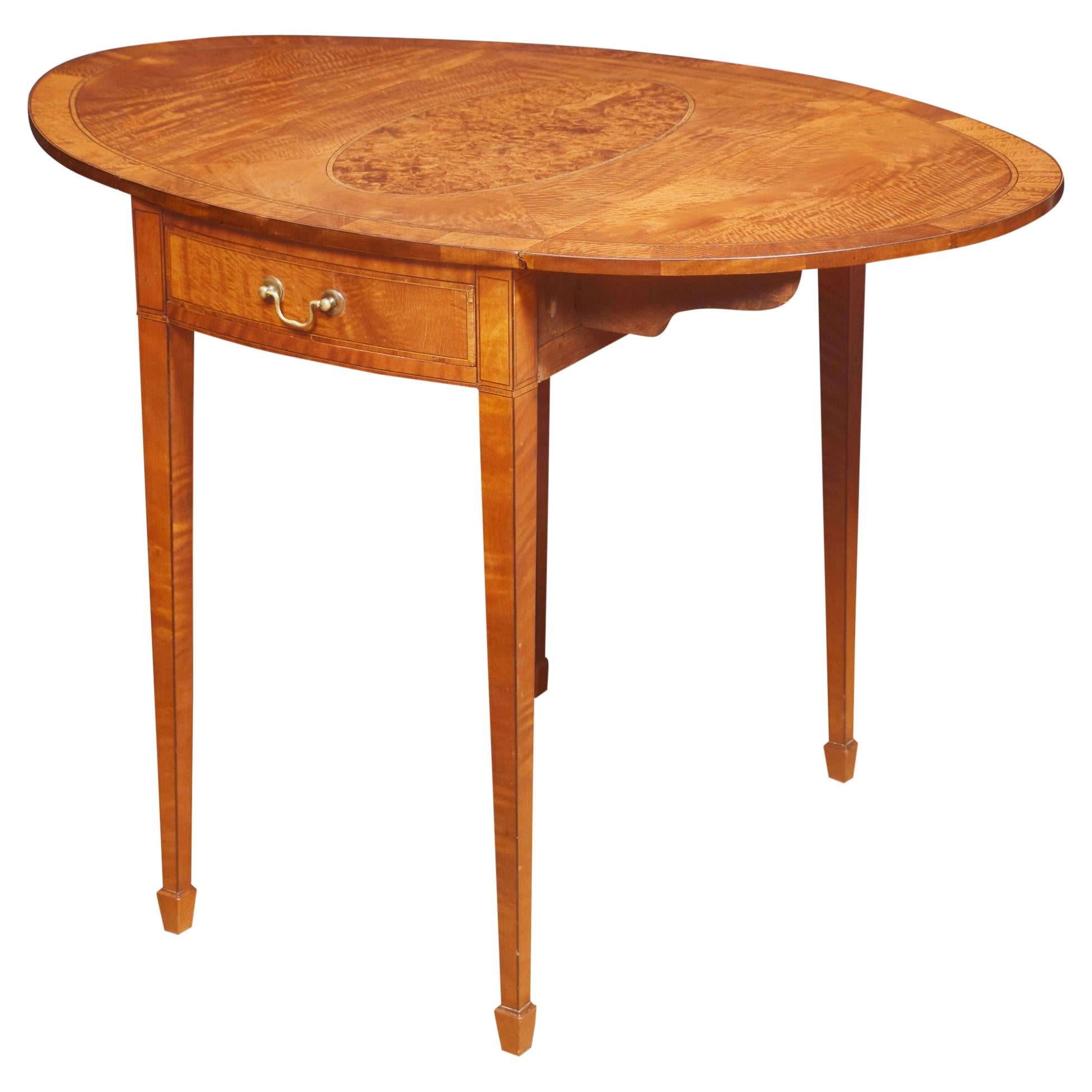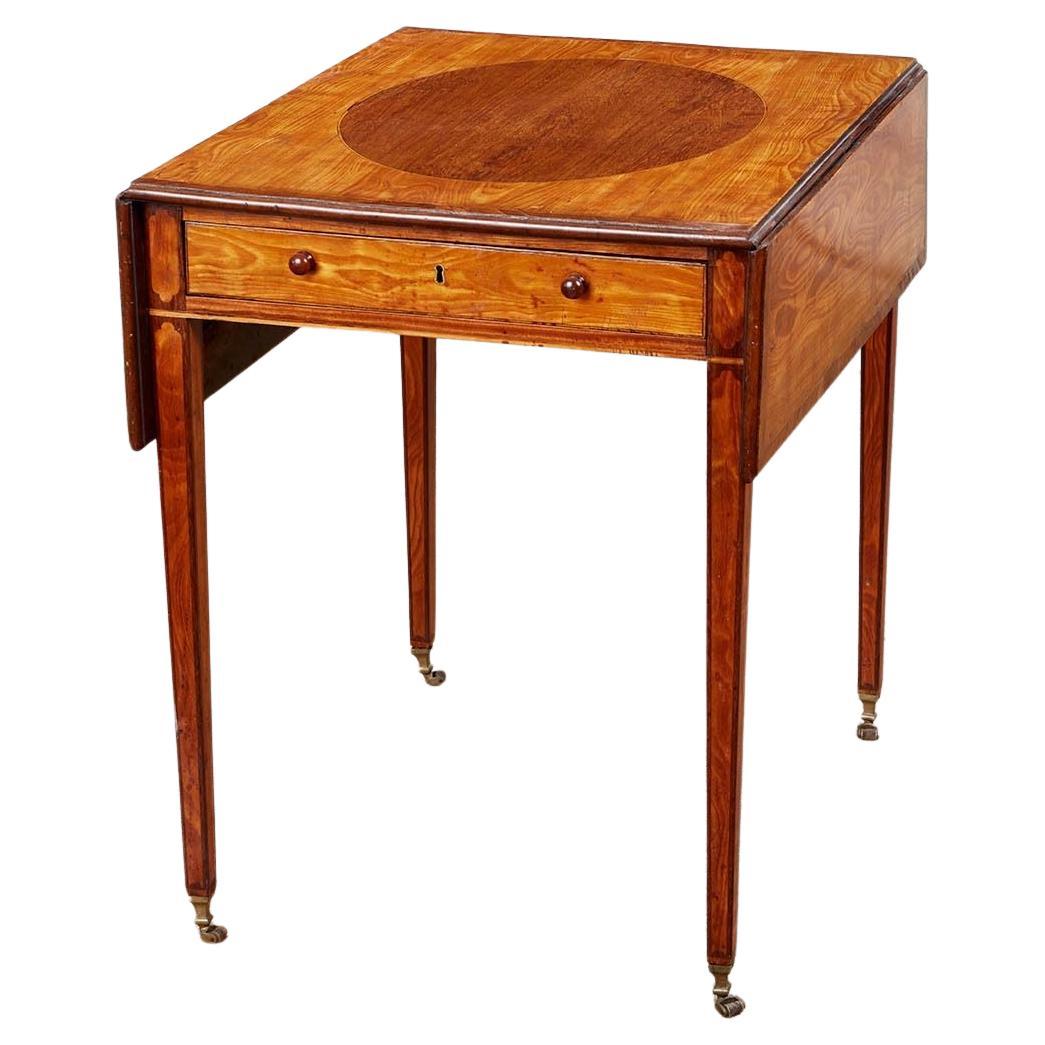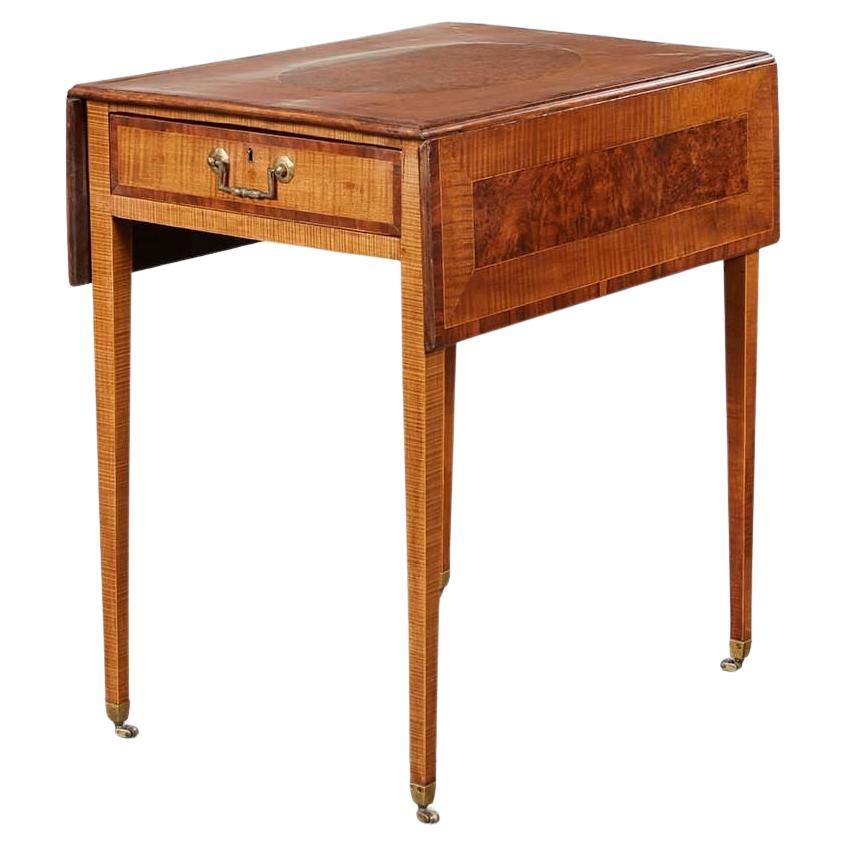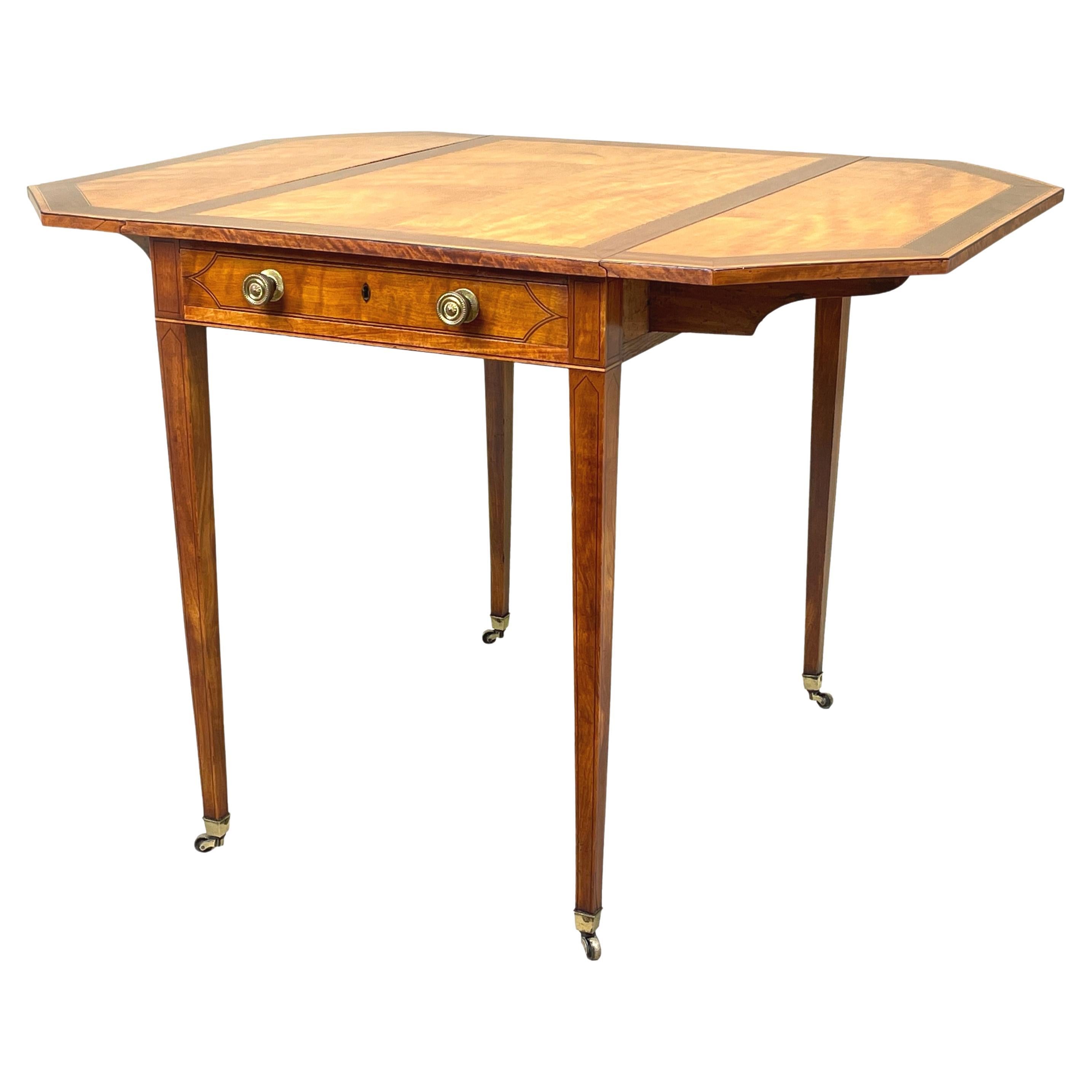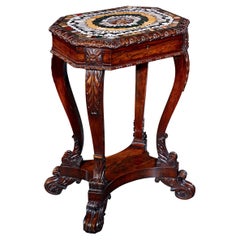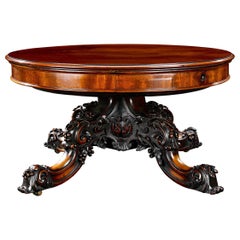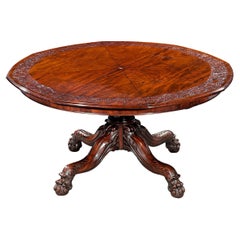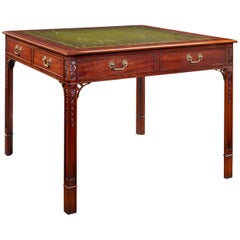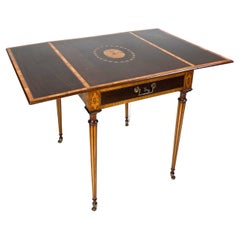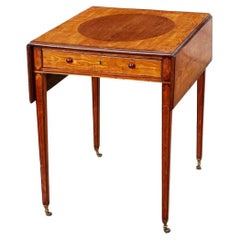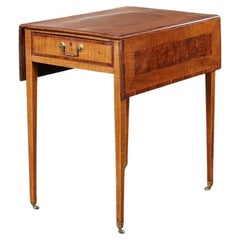Items Similar to George III Pembroke Table attributed to Ince & Mayhew
Want more images or videos?
Request additional images or videos from the seller
1 of 5
George III Pembroke Table attributed to Ince & Mayhew
$24,500
£19,078.97
€21,702.27
CA$35,284.08
A$38,719.88
CHF 20,223.58
MX$462,939.18
NOK 256,167.49
SEK 238,924.39
DKK 162,085.51
About the Item
This extraordinary George III-period Pembroke table by London cabinetmakers Ince & Mayhew displays the understated sophistication of the late Georgian era. The surface of the table — including both the central panel and the signature Pembroke hinged flaps — is beautifully detailed with satinwood marquetry, inlaid with a fan medallion and foliate motifs executed with the greatest precision and craftsmanship. The table is set upon slender, tapering legs. The design is indicative of the rising influence of and interest in Neoclassical patterns, favoring motifs from nature or Classical antiquity over the extravagance of the Rococo style.
William Ince and John Mayhew joined their skills as furniture designers and cabinetmakers, opening a firm together on Broad Street in 1759. Over the next forty years, the duo would execute many commissions, and develop a volume of engraved designs entitled The Universal System of Household Furniture — an effort to compete with the success of Thomas Chippendale's Director. The firm's output is often described as a balance between Chippendale's heavy constructions and Hepplewhite's slender forms, frequently utilizing natural colored woods embellished with inlay and engravings. Those stylistic signatures are present in this Pembroke table, placing it as an excellent example of the cabinetmakers' timeless aesthetics.
Circa 1790
28 1/8" high x 30" wide x 39 3/8" deep.
- Attributed to:Ince & Mayhew (Maker)
- Dimensions:Height: 28.13 in (71.46 cm)Width: 30 in (76.2 cm)Depth: 39.38 in (100.03 cm)
- Style:Georgian (In the Style Of)
- Materials and Techniques:
- Place of Origin:
- Period:
- Date of Manufacture:circa 1790
- Condition:
- Seller Location:New Orleans, LA
- Reference Number:Seller: 31-59991stDibs: LU891132337742
About the Seller
5.0
Recognized Seller
These prestigious sellers are industry leaders and represent the highest echelon for item quality and design.
Established in 1912
1stDibs seller since 2010
114 sales on 1stDibs
Typical response time: 4 hours
- ShippingRetrieving quote...Shipping from: New Orleans, LA
- Return Policy
More From This Seller
View AllSpecimen Table Attributed to William Trotter
By William Trotter
Located in New Orleans, LA
Octagonal Specimen Table
William Trotter
Early 19th Century
This extraordinary early 19th-century Scottish specimen table is a museum-quality masterpiece attributed to William Trott...
Category
Antique Early 19th Century Scottish Regency Side Tables
Materials
Agate
19th Century Exhibition Model of Expanding Table by Samuel Hawkins
By Samuel Hawkins
Located in New Orleans, LA
A masterpiece of both cabinetmaking and mechanical engineering, this one-of-a-kind expanding table was crafted by the renowned cabinetmaker Samuel Hawkins of London for the Great Exhibition of 1851. Diminutive in size, the fascinating table was designed as a model to demonstrate Hawkins’ innovative patent screw movement to visitors of the Exhibition – six million people in total over five months. It was exhibited again a century later at the Victoria & Albert Museum during the Festival of Britain, an event intended “to symbolise two main qualities of the national character: realism and strength on the one hand, and, on the other, independence and imagination” (Catalogue of the Exhibition, 1951, p.117). To this day, the miniature masterpiece demonstrates the quest of English furniture makers to combine technical innovation with superb craftsmanship.
Displaying exceptional ingenuity, Hawkins’ wind-out screw mechanism allowed one to extend the table’s base to accommodate concentric leaves with the simple crank of a handle. It is based on the inventive expanding table originally designed by Robert Jupe in 1835, which used a swivel mechanism to separate sections of the tabletop and allow for segmented leaves to be inserted. Hawkins’ tabletop, on the other hand, extends outwards directly from the center in order to accommodate additional leaves around its diameter. This unique design allowed the mechanism to also smoothly operate on rectangular tables, which could be wound out from the middle to allow for more table space.
Hawkins was not alone in his endeavor to combine the technical merits of engineering and mechanics with the most artful pursuit of cabinetmaking. The first half of the 19th century saw a prolific increase in the popularity of applying new ideas to traditional furniture principles, which allowed furniture to serve many purposes. The resulting “patent” furniture was practical and refined, though few were as innovative as Hawkins’ prodigious design.
Carved with the year of the Exhibition on the beautifully designed pedestal base, the table is a testament to the significance of this innovation. The model is mentioned in detail in the catalog of the Great Exhibition of 1851, the first international exhibition of industry, manufacturing, and science. Held at London’s dazzling Crystal Palace, its visitors were treated to exhibits from around the globe, including feats of engineering, innovations in industry, and marvels of design. Queen Victoria herself was a frequent visitor, along with her husband, Prince Albert, and others including Charlotte...
Category
Antique 19th Century English Other Tables
Materials
Mahogany
Expanding Jupe Dining Table by Johnstone and Jeanes
By Robert Jupe
Located in New Orleans, LA
This exceptionally rare circular expanding dining table was designed by Robert Jupe and crafted by the English cabinetmakers Johnstone & Jeanes, successors to Johnstone, Jupe & Co. One of only a handful known from the firm, this table illustrates the Victorian era's quest to combine technical innovation with superb and beautiful craftsmanship. Complete with its original leaves, the table’s circular top is formed from eight separate segments. When the top is rotated, an ingenious swivel mechanism causes the sections to diverge, allowing a set of small or large leaves to be inserted for an adjustable increase in size.
The design for the table was patented by Robert Jupe in 1835, who had envisioned “an improved expanding table so constructed that the sections composing its surface may be caused to diverge from a common center and that the spaces caused thereby may be filled up by inserting leaves or filling pieces.” The first of these fascinating tables were created between 1835 and 1840 during his partnership with John Johnstone and their firm of Johnstone, Jupe & Co. in London. Jupe left the company in 1840, after which the firm changed its name due to a new partnership and became Johnstone & Jeanes. The firm would eventually achieve international fame for its remarkable designs, exhibiting a "circular table made on the expanding principle" like this one at the Great Exhibition of 1851.
Jupe was not alone in his fascination with combining the technical merits of engineering and mechanics with the more artful pursuit of cabinet making. The first half of the 19th century saw a prolific increase in the popularity of applying new ideas to furniture principles, which allowed furniture to serve many purposes. The resulting “patent” furniture...
Category
Antique 19th Century English Victorian Dining Room Tables
Materials
Mahogany
Regency Library Table
Located in New Orleans, LA
This handsome Regency library desk is crafted of rich mahogany and features the straightforward design prevalent in England during the early 19th ...
Category
Antique Early 19th Century English Regency Desks and Writing Tables
Materials
Leather, Mahogany
$14,500
George II Mahogany Pembroke Table by Thomas Chippendale
By Thomas Chippendale
Located in New Orleans, LA
Pembroke Table
Thomas Chippendale
Circa 1780
This highly significant Pembroke table is a rare example of Thomas Chippendale's exceptional craftsmanship, showcasing his legacy's unpa...
Category
Antique 18th Century English Chippendale Game Tables
Materials
Brass
English Mahogany Writing Table, Early 19th Century
Located in New Orleans, LA
This exquisite writing desk is crafted of rich mahogany and features the straightforward design prevalent in England during the early 19th century. A luxurious leather-covered top pr...
Category
Antique 19th Century English Regency Desks and Writing Tables
Materials
Brass
You May Also Like
Pembroke table attributed to Ince and Mayhew
By Ince & Mayhew
Located in Folkestone, GB
An exceptionally fine quality late 18th century marquetry Pembroke table in the manner of Ince and Mayhew. Constructed in Ameranth, Partri...
Category
Antique Late 18th Century English Hepplewhite Drop-leaf and Pembroke Tables
Materials
Purpleheart
George III Style Satinwood Pembroke Table
Located in Cheshire, GB
George III style satinwood Pembroke table, the oval top with central amboyna inlay incorporating two hinged flaps, above a drawer, on square section tapering legs, terminating in spa...
Category
Early 20th Century British Drop-leaf and Pembroke Tables
Materials
Satinwood
$2,351 Sale Price
38% Off
Georgian Satinwood Pembroke Table
Located in Greenwich, CT
Very fine George III satinwood Pembroke table, the rectangular top with purpleheart oval center and cross banding, having two recta...
Category
Antique Late 18th Century English Georgian Drop-leaf and Pembroke Tables
Materials
Mahogany, Purpleheart, Satinwood
Georgian Harewood Pembroke Table
Located in Greenwich, CT
Fine George III harewood, burr yew and rosewood Pembroke table, the rectangular top with central panels of burr yew, framed in tiger grained harewood with rosewood cross banding, ove...
Category
Antique Late 18th Century English Georgian End Tables
Materials
Harewood
George III Satinwood Pembroke Table
Located in Essex, MA
Rectangular with D shaped leaves. The frieze with a drawer flanked by oval oak leaf inlay. Square tapered legs with casters.
Category
Antique 1790s English George III Drop-leaf and Pembroke Tables
Materials
Brass
Georgian Satinwood Pembroke Table
Located in Bedfordshire, GB
A very fine quality 18th century Georgian Sheraton period satinwood pembroke table having superbly figured two flap top, with attractive padouk wood crossbanded decoration, over one frieze drawer opposed by dummy drawer to reverse, retaining original brass handles, raised on elegant square tapering legs, terminating on original brass castors.
Pembroke tables became one of the most popular pieces of furniture around the middle of the 18th century, owing largely to their versatility and their plethora of different functions. In fact George Hepplewhite himself actually described Pembroke tables as "the most useful of tables" and many references can be found to them in the literature of the time. People such as Jane Austen even described them being used for dining at, or for writing at, whilst there is even reference to them being used in other places around the house such as for ladies to sit and and carry out their embroidery.
One thing that is certain is that the fact they are incredibly versatile even in todays world and can be used for many, many different purposes. The option of being able to use the two flaps to create significant variations in the size of the table top surface is certainly a popular and useful feature.
This particular Georgian Satinwood...
Category
Antique Late 18th Century English Sheraton Drop-leaf and Pembroke Tables
Materials
Padouk, Satinwood
More Ways To Browse
Drop Leaf Dining Table 8 Legs
18th Century Chippendale Pembroke Table
19th Century French Drop Leaf Table
Gateleg Drop Leaf Tables
Gateleg Drop Leaf
Large Wood Drop Leaf Dining Table
Cherry Drop Leaf Dining Table
Oak Gate Leg Table Dining Table
Antique Painted Drop Leaf Table
Rectangular Drop Leaf Table
Oak Gateleg Table
Cherry Drop Leaf Table
Oval Pembroke
Maple Drop Leaf Dining Table
Antique Drop Leaf Gateleg Table
English Oak Drop Leaf
Maple Drop Leaf
2 Drawer Drop Leaf Table
